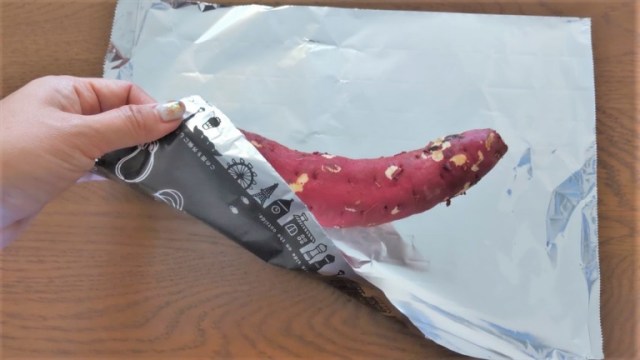
Kuro Foil is exactly the kind of culinary black magic we want at this time of year.
One of Japan’s favorite snacks at this time of year is yaki-imo, roasted sweet potatoes. These spuds are at their most scrumptious when you can minimize the time between roasting them and taking your first bite, and the best way to do that is by roasting them yourself at home.
So on our last trip to the grocery store, we picked up a pair of sweet potatoes to cook up, and also a pack of a special kind of Japanese aluminum foil that its makers say will make your sweet potatoes taste extra delicious.
Made by Osaka-based Toyo Aluminum Ekco Products Co., it’s called Ishiyaki-imo Kuro Foil. Kuro is the Japanese word for “black,” and sure enough, one side of this sweet potato-oriented foil is primarily black in color.
As luck would have it, we also happened to have a roll of regular Toyo Aluminum Ekco on hand. Aside from the color, we couldn’t tell any difference between the two. Both felt the same to the touch, and according to their packaging they have an identical thickness of 11 micrometers (0.00043 inches).
▼ The special yaki-imo foil (left) and the regular kind (right)
However, the packaging for Ishiyaki-imo Kuro Foil has a chart that claims the black foil heats the sweet potatoes’ core more quickly and to a higher temperature.
▼ Kuro Foil (red line) vs, regular foil (blue line)
Temperature in Celsius on the vertical axis and minutes in the oven on the horizontal
To test that claim, we wrapped one sweet potato in each kind of foil and popped them in the toaster oven at 1,000 kilowatts for 20 minutes.
▼ We wrapped them tightly, making sure there were no gaps for heat to leak out of during cooking.
Then we left them roast for 20 minutes. After we pulled them out, we started with a check of the regular foil-roasted sweet potato, and…
…we were immediately disappointed. The potato pulled apart with a loud “SNAP!”, and it didn’t look or smell much different from a raw sweet potato. This shouldn’t be taken as a mark against the quality of Toyo Aluminum Ekco’s normal aluminum foil, though, but against the quality of our pre-cooking preparations. The temperature comparison chart on the Kuro Foil package has “10 minutes” marked near its center, so we’d just sort of assumed 20 minutes is how long you’re supposed to roast sweet potatoes for. It turns out, though, that if you’re starting with a raw sweet potato, you’re supposed to give it a full hour in the oven.
With that revelation, we figured the Black Foil sweet potato wasn’t going to have come out any better, since it too had only been cooked for a third of the recommended time. So imagine our surprise when…
…instead of snapping, the two halves pulled smoothly apart, revealing a fluffy, fragrant yaki-imo!
▼ Regular foil (left) vs. Kuro Foil (right)
Amazingly, the Kuro Foil sweet potato had roasted all the way to the core, allowing its natural sugars to caramelize and rewarding us with a moist, sweet, and quickly-devoured yaki-imo.
By the way, you might have noticed that the Kuro Foil’s packaging includes an extra mo (も) character.
Though it’s not part of the official name, Toyo Aluminum Ekco added this additional mo, meaning “also,” as a reminder that while yaki-imo are the reason the product was developed, it can also be used for better roasting of other foods like eggplant, mushrooms, and onions.
We should point out that Ishiyaki-imo Kuro Foil isn’t particularly cheap. Our 4.6-meter (15.1-foot) roll cost us 360 yen (US$2.60), which isn’t itself a cost-prohibitive price, but it still quite a bit more than you’d pay for that amount of normal foil in Japan. Still, it really does seem to work as advertised, with its more efficient cooking working like a time machine that let us enjoy our yaki-imo much sooner than regular foil would.
Photos ©SoraNews24
● Want to hear about SoraNews24’s latest articles as soon as they’re published? Follow us on Facebook and Twitter!
[ Read in Japanese ]

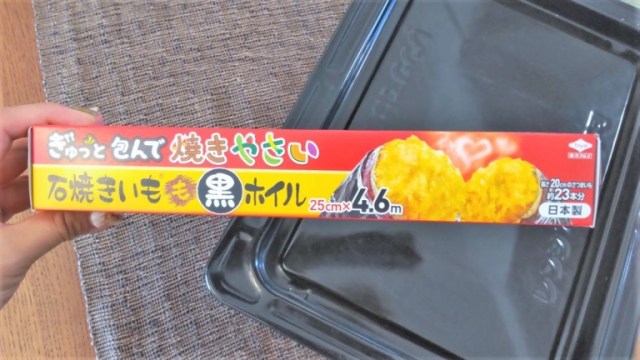
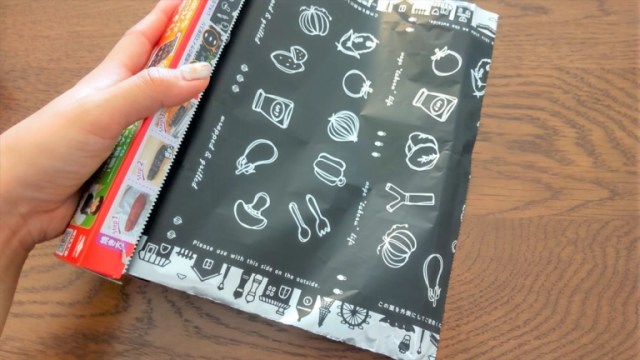
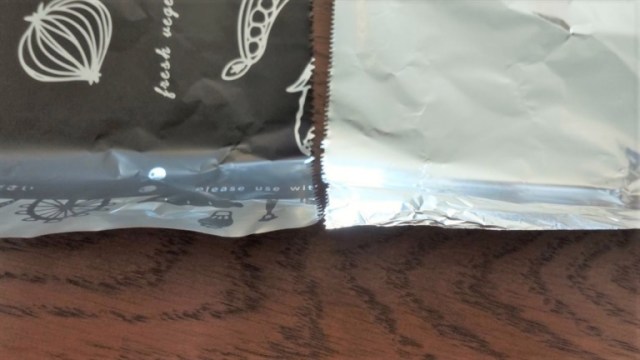
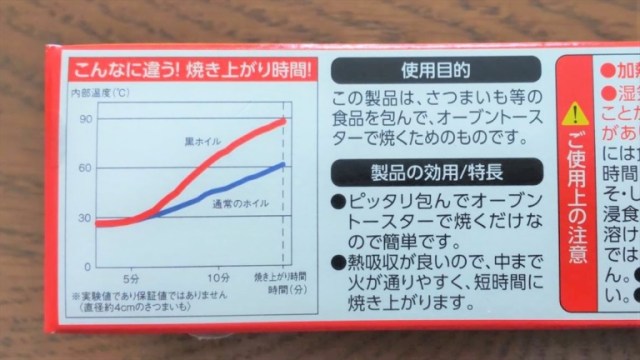
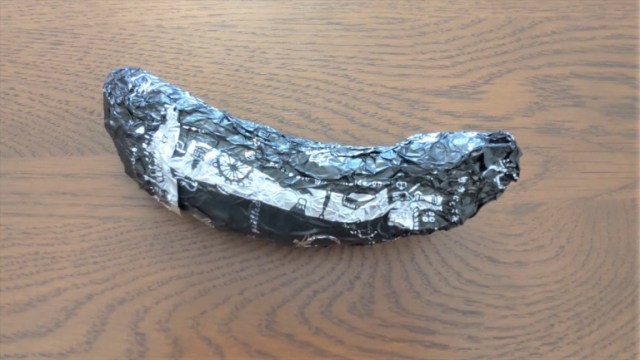
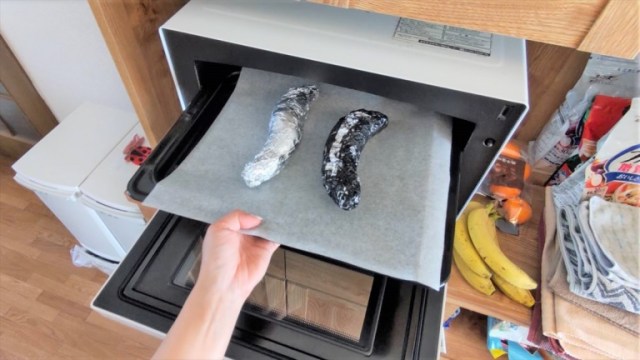


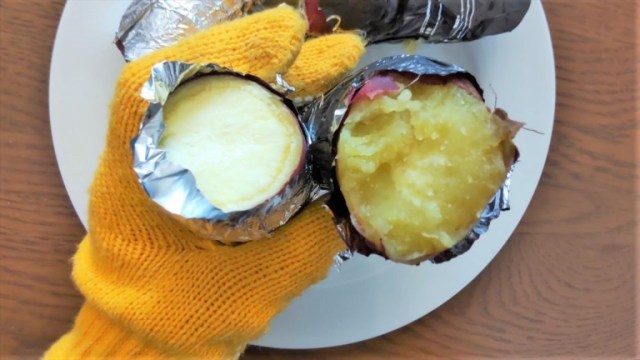
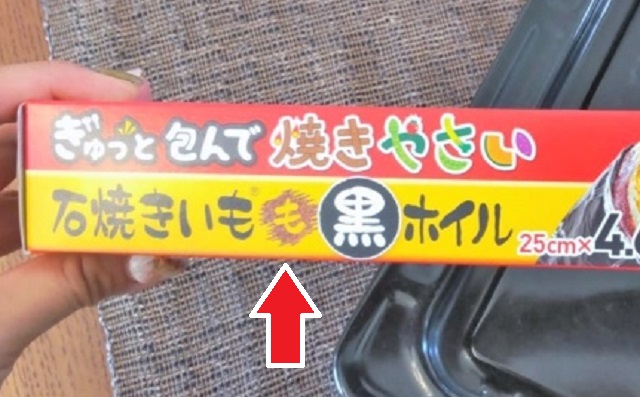
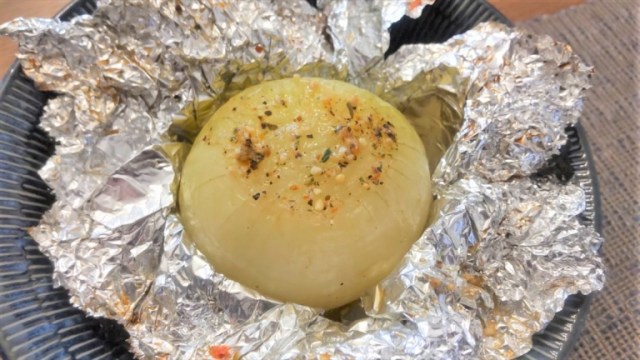
 You’re not seeing things, that’s a cat selling roasted sweet potatoes
You’re not seeing things, that’s a cat selling roasted sweet potatoes Hot and sweet — these new Kit Kats are ready to be baked!
Hot and sweet — these new Kit Kats are ready to be baked! We make anime food from Studio Ghibli movie Laputa: Castle in the Sky
We make anime food from Studio Ghibli movie Laputa: Castle in the Sky How to make a beautiful matcha cheesecake using a microwave, toaster oven, and hardly any effort
How to make a beautiful matcha cheesecake using a microwave, toaster oven, and hardly any effort Automatic cup noodle maker developed, makes instant ramen in an instant
Automatic cup noodle maker developed, makes instant ramen in an instant Foreigner’s request for help in Tokyo makes us sad for the state of society
Foreigner’s request for help in Tokyo makes us sad for the state of society Japanese-style accommodation at the new Premium Dormy Inn hotel in Asakusa will blow your mind
Japanese-style accommodation at the new Premium Dormy Inn hotel in Asakusa will blow your mind Ghibli Park now selling “Grilled Frogs” from food cart in Valley of Witches
Ghibli Park now selling “Grilled Frogs” from food cart in Valley of Witches Seaside scenery, history, and so many desserts on Yokohama’s Akai Kutsu【Japan Loop Buses】
Seaside scenery, history, and so many desserts on Yokohama’s Akai Kutsu【Japan Loop Buses】 All-you-can-drink Starbucks and amazing views part of Tokyo’s new 170 meter-high sky lounge
All-you-can-drink Starbucks and amazing views part of Tokyo’s new 170 meter-high sky lounge Smash Bros. director Sakurai stabs Kirby in the face, has delicious justification for it
Smash Bros. director Sakurai stabs Kirby in the face, has delicious justification for it New virgin-seducing lingerie collection from Japan throws virtue out the window【Photos】
New virgin-seducing lingerie collection from Japan throws virtue out the window【Photos】 Gorgeous Chinese woman creates one of Japan’s favorite mobile games, encourages microtransactions
Gorgeous Chinese woman creates one of Japan’s favorite mobile games, encourages microtransactions Akihabara pop-up shop sells goods made by Japanese prison inmates
Akihabara pop-up shop sells goods made by Japanese prison inmates Top 27 ugliest album covers from Yugoslavia 【Photos】
Top 27 ugliest album covers from Yugoslavia 【Photos】 McDonald’s new Happy Meals offer up cute and practical Sanrio lifestyle goods
McDonald’s new Happy Meals offer up cute and practical Sanrio lifestyle goods Japanese ramen restaurants under pressure from new yen banknotes
Japanese ramen restaurants under pressure from new yen banknotes French Fries Bread in Tokyo’s Shibuya becomes a hit on social media
French Fries Bread in Tokyo’s Shibuya becomes a hit on social media Red light district sushi restaurant in Tokyo shows us just how wrong we were about it
Red light district sushi restaurant in Tokyo shows us just how wrong we were about it New private rooms on Tokaido Shinkansen change the way we travel from Tokyo to Kyoto
New private rooms on Tokaido Shinkansen change the way we travel from Tokyo to Kyoto Tokyo Tsukiji fish market site to be redeveloped with 50,000-seat stadium, hotel, shopping center
Tokyo Tsukiji fish market site to be redeveloped with 50,000-seat stadium, hotel, shopping center Japanese city loses residents’ personal data, which was on paper being transported on a windy day
Japanese city loses residents’ personal data, which was on paper being transported on a windy day Beautiful Ghibli sealing wax kits let you create accessories and elegant letter decorations【Pics】
Beautiful Ghibli sealing wax kits let you create accessories and elegant letter decorations【Pics】 Secret Kitchen bento serves Japanese flowers, birds, wind and moon in a box, but is it worth it?
Secret Kitchen bento serves Japanese flowers, birds, wind and moon in a box, but is it worth it? New definition of “Japanese whiskey” goes into effect to prevent fakes from fooling overseas buyers
New definition of “Japanese whiskey” goes into effect to prevent fakes from fooling overseas buyers Our Japanese reporter visits Costco in the U.S., finds super American and very Japanese things
Our Japanese reporter visits Costco in the U.S., finds super American and very Japanese things Studio Ghibli releases Kiki’s Delivery Service chocolate cake pouches in Japan
Studio Ghibli releases Kiki’s Delivery Service chocolate cake pouches in Japan More foreign tourists than ever before in history visited Japan last month
More foreign tourists than ever before in history visited Japan last month New Pokémon cakes let you eat your way through Pikachu and all the Eevee evolutions
New Pokémon cakes let you eat your way through Pikachu and all the Eevee evolutions Disney princesses get official manga makeovers for Manga Princess Cafe opening in Tokyo
Disney princesses get official manga makeovers for Manga Princess Cafe opening in Tokyo Sales of Japan’s most convenient train ticket/shopping payment cards suspended indefinitely
Sales of Japan’s most convenient train ticket/shopping payment cards suspended indefinitely Sold-out Studio Ghibli desktop humidifiers are back so Totoro can help you through the dry season
Sold-out Studio Ghibli desktop humidifiers are back so Totoro can help you through the dry season Japanese government to make first change to romanization spelling rules since the 1950s
Japanese government to make first change to romanization spelling rules since the 1950s Ghibli founders Toshio Suzuki and Hayao Miyazaki contribute to Japanese whisky Totoro label design
Ghibli founders Toshio Suzuki and Hayao Miyazaki contribute to Japanese whisky Totoro label design Doraemon found buried at sea as scene from 1993 anime becomes real life【Photos】
Doraemon found buried at sea as scene from 1993 anime becomes real life【Photos】 Tokyo’s most famous Starbucks is closed
Tokyo’s most famous Starbucks is closed One Piece characters’ nationalities revealed, but fans have mixed opinions
One Piece characters’ nationalities revealed, but fans have mixed opinions We asked a Uniqlo employee what four things we should buy and their suggestions didn’t disappoint
We asked a Uniqlo employee what four things we should buy and their suggestions didn’t disappoint Enjoy the taste of fire-roasted sweet potatoes in a bottle with new “You Yaki-imo” liquor
Enjoy the taste of fire-roasted sweet potatoes in a bottle with new “You Yaki-imo” liquor Weird Japanese vending machine find gives us unique sweet potato sweets
Weird Japanese vending machine find gives us unique sweet potato sweets We may never stop eating these rare deluxe apple pastries from Japan’s Chateraise sweets shop
We may never stop eating these rare deluxe apple pastries from Japan’s Chateraise sweets shop Small children have magnetic “cat-attracting” ability, adorable photos from Japan show
Small children have magnetic “cat-attracting” ability, adorable photos from Japan show Sweet potato sweets season arrives at convenience store Family Mart, so let’s go taste-test-crazy
Sweet potato sweets season arrives at convenience store Family Mart, so let’s go taste-test-crazy Burger King Japan has two new burgers with jet-black buns…oh, and BLACK CHEESE!
Burger King Japan has two new burgers with jet-black buns…oh, and BLACK CHEESE! How to make your own hoshi-imo Japanese dried sweet potato snacks【SoraKitchen】
How to make your own hoshi-imo Japanese dried sweet potato snacks【SoraKitchen】 Tokyo cafe serves up the artsiest version of a drinkable roasted sweet potato that we’ve seen yet
Tokyo cafe serves up the artsiest version of a drinkable roasted sweet potato that we’ve seen yet Traditional noodles undergo a cute evolution in Kawaii Company’s new rainbow somen
Traditional noodles undergo a cute evolution in Kawaii Company’s new rainbow somen Does the new Space Tea from Japan’s Village Vanguard actually taste like space?【Taste Test】
Does the new Space Tea from Japan’s Village Vanguard actually taste like space?【Taste Test】 Hey! You Can Drink Sweet Potatoes, says Japanese beverage maker with new drink
Hey! You Can Drink Sweet Potatoes, says Japanese beverage maker with new drink Japanese vending machine is the only one of its kind in Japan, dubbed the “phantom machine”
Japanese vending machine is the only one of its kind in Japan, dubbed the “phantom machine” Japan now has drinkable roasted sweet potato, and it’s practically a dessert in a bottle!
Japan now has drinkable roasted sweet potato, and it’s practically a dessert in a bottle! Crazy Japanese man achieves dream of filling his bathtub with curry rice【Photos】
Crazy Japanese man achieves dream of filling his bathtub with curry rice【Photos】 Japanese sweets box from Amazon Japan is a treasure trove of dagashi nostalgia
Japanese sweets box from Amazon Japan is a treasure trove of dagashi nostalgia
Leave a Reply